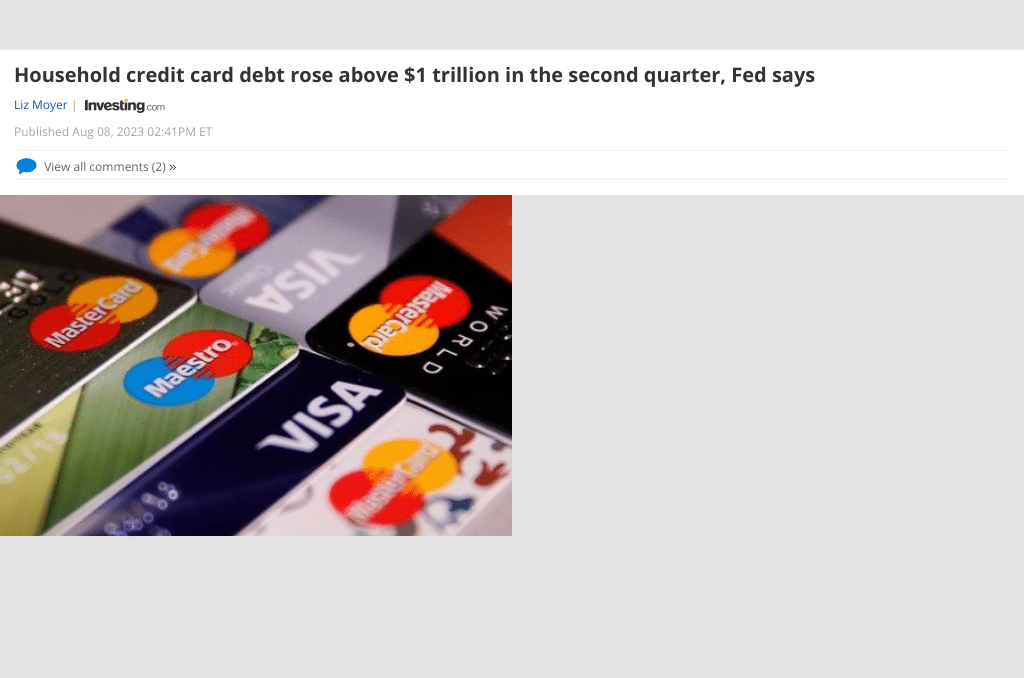The United States has reached a significant milestone in its credit card debt, with balances surpassing $1 trillion for the first time in history. This record-breaking figure was reported by the Federal Reserve Bank of New York and reflects the strong consumer spending that has taken place as the US economy recovers from the pandemic.
The increase in credit card balances is part of a broader trend of rising consumer credit in the country. Overall, consumer credit rose by $18.5 billion in June, reaching a total of $3.735 trillion.[0] This growth was mainly driven by nonrevolving credit, which includes lump sum loans such as student loans, mortgages, and car loans.
The rise in credit card usage and debt is a cause for concern, especially given the current high interest rates. The average credit card annual percentage rate (APR) recently hit a new record of 20.53%, surpassing the previous high of 19% in July 1991.[1] This means that consumers are paying a steep price for carrying credit card debt.
A recent survey by Bankrate revealed that 47% of credit cardholders currently carry debt from month to month, up from 46% in December 2022 and 39% in December 2021.[2] This indicates that more cardholders are struggling to pay off their balances, despite the high interest rates.
The increase in credit card debt is particularly prominent among lower-income households. While credit card debt is found across all income groups, a higher percentage of lower-income households carry card balances. For example, 53% of cardholders with annual household incomes below $50,000 have credit card debt, compared to 38% of cardholders with annual household incomes of $100,000 or more.
The Federal Reserve's Quarterly Report on Household Debt and Credit revealed that total household debt increased slightly by $16 billion in the second quarter of 2023, reaching $17.06 trillion.[3] Credit card balances saw the largest increase of all debt types, rising by $45 billion to reach $1.03 trillion. This marks the first time that credit card debt has surpassed $1 trillion in nominal terms.
Joelle Scally, a regional economic principal at the New York Fed, commented on the brisk growth in credit card balances in the second quarter.[4] She also noted that delinquency rates have edged up but appear to have normalized to pre-pandemic levels.[4]
The increase in credit card debt can be attributed to various factors, including emergency expenses and rising interest rates. Bankrate reported that emergency expenses are the main driver of credit card debt for all income groups.[2] However, higher-income households are more likely to have been in debt for at least a year.[5]
While there are concerns about the rising balances and delinquency rates, researchers at the New York Fed stated that there is little evidence of widespread financial distress for consumers.[6] American consumers have shown resilience in the face of economic difficulties, although the resumption of student loan payments in the fall may add additional financial strain for many borrowers.[7]
In conclusion, the United States has reached a significant milestone in credit card debt, surpassing $1 trillion for the first time. This increase in balances reflects the strong consumer spending that has taken place as the US economy recovers from the pandemic. However, the high interest rates and rising balances raise concerns about the financial strain that many borrowers may face.[8] It remains to be seen how the resumption of student loan payments will impact credit card debt and consumer financial health in the coming months.[9]
0. “US: Consumer Credit rose by $17.85 billion in June, surpassing expectations” FXStreet, 8 Aug. 2023, https://www.fxstreet.com/news/us-consumer-credit-rose-by-1785-billion-in-june-surpassing-expectations-202308071917
1. “Credit card debt hits $1T for the first time ever” Fox Business, 8 Aug. 2023, https://www.foxbusiness.com/economy/credit-card-debt-hits-1-trillion-first-time-ever
2. “Most upper class Americans are carrying credit card debt” Audacy, 8 Aug. 2023, https://www.audacy.com/knxnews/news/national/most-upper-class-americans-are-carrying-credit-card-debt
3. “Credit Card Debt Hits Record High As Overall Debt Tops $17 Trillion | KLVI AM 560” iHeart, 8 Aug. 2023, https://klvi.iheart.com/content/2023-08-08-credit-card-debt-hits-record-high-as-overall-debt-tops-17-trillion/
4. “Household credit card debt rose above $1 trillion in the second quarter, Fed says By Investing.com” Investing.com, 8 Aug. 2023, https://www.investing.com/news/economy/household-credit-card-debt-rose-above-1-trillion-in-the-second-quarter-fed-says-3148626
5. “More Cardholders Carrying Credit Card Balances In High Rate Environment” Bankrate.com, 7 Aug. 2023, https://www.bankrate.com/finance/credit-cards/credit-card-debt-survey
6. “Credit-card balances in the US top $1 trillion for first time” Chicago Tribune, 8 Aug. 2023, https://www.chicagotribune.com/business/ct-biz-credit-card-balances-20230808-q4mmrfd2xzd65nn3mf64pj4baa-story.html
7. “Credit Card Markets Head Back to Normal after Pandemic Pause – Liberty Street Economics” Liberty Street Economics -, 8 Aug. 2023, https://libertystreeteconomics.newyorkfed.org/2023/08/credit-card-markets-head-back-to-normal-after-pandemic-pause
8. “Americans’ credit card debt hits a record $1 trillion” CNN, 8 Aug. 2023, https://www.cnn.com/2023/08/08/economy/us-household-credit-card-debt/index.html
9. “Credit card balances hit $1 trillion. Here's why bankers remain upbeat.” American Banker, 8 Aug. 2023, https://www.americanbanker.com/news/credit-card-balances-hit-1-trillion-heres-why-bankers-remain-upbeat


